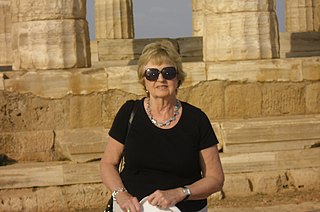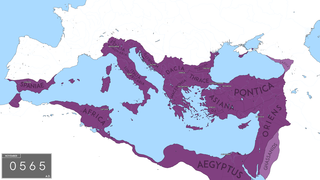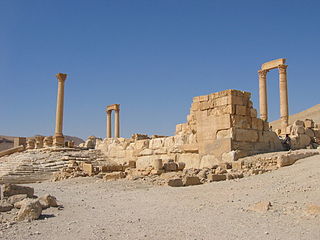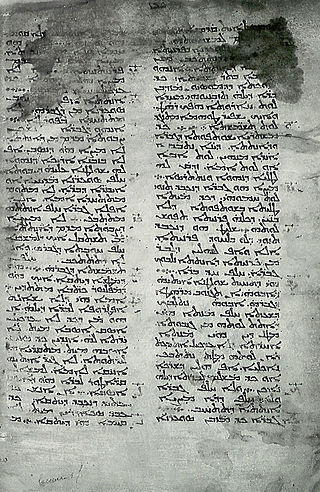Procopius of Caesarea was a prominent late antique Greek scholar and historian from Caesarea Maritima. Accompanying the Roman general Belisarius in Emperor Justinian's wars, Procopius became the principal Roman historian of the 6th century, writing the History of the Wars, the Buildings, and the Secret History.

Year 515 (DXV) was a common year starting on Thursday of the Julian calendar. At the time, it was known as the Year of the Consulship of Florentius and Anthemius. The denomination 515 for this year has been used since the early medieval period, when the Anno Domini calendar era became the prevalent method in Europe for naming years.

Jovian was Roman emperor from June 363 to February 364. As part of the imperial bodyguard, he accompanied Emperor Julian on his campaign against the Sasanian Empire. Julian was killed in battle, and the exhausted and ill-provisioned army declared Jovian his successor. Unable to cross the Tigris, Jovian extricated his troops from enemy territory by making peace with the Sasanids on humiliating terms. He spent the rest of his eight-month reign traveling back to Constantinople. After his arrival at Edessa, Jovian was petitioned by bishops over doctrinal issues concerning Christianity. He died at Dadastana, never having reached the capital.

Osroene or Osrhoene was an ancient region and state in Upper Mesopotamia. The Kingdom of Osroene, also known as the "Kingdom of Edessa", according to the name of its capital city, existed from the 2nd century BC, up to the 3rd century AD, and was ruled by the Abgarid dynasty. Generally allied with the Parthians, the Kingdom of Osroene enjoyed semi-autonomy to complete independence from the years of 132 BC to AD 214. Though ruled by a dynasty of Arab origin, the kingdom's population was of mixed culture, being Syriac-speaking from the earliest times. The city's cultural setting was fundamentally Syriac, alongside strong Greek and Parthian influences, though some Arab cults were also attested at Edessa.

Petronius Maximus was Roman emperor of the West for two and a half months in 455. A wealthy senator and a prominent aristocrat, he was instrumental in the murders of the Western Roman magister militum, Aëtius, and the Western Roman emperor, Valentinian III.
The Henotikon was a christological document issued by Byzantine emperor Zeno in 482, in an unsuccessful attempt to reconcile the differences between the supporters of the Council of Chalcedon and the council's opponents. It was followed by the Acacian schism.
The Roman–Persian Wars, also known as the Roman–Iranian Wars, were a series of conflicts between states of the Greco-Roman world and two successive Iranian empires: the Parthian and the Sasanian. Battles between the Parthian Empire and the Roman Republic began in 54 BC; wars began under the late Republic, and continued through the Roman and Sasanian empires. A plethora of vassal kingdoms and allied nomadic nations in the form of buffer states and proxies also played a role. The wars were ended by the early Muslim conquests, which led to the fall of the Sasanian Empire and huge territorial losses for the Byzantine Empire, shortly after the end of the last war between them.
Peter John Heather is a British historian of late antiquity and the Early Middle Ages. Heather is Chair of the Medieval History Department and Professor of Medieval History at King's College London. He specialises in the fall of the Western Roman Empire and the Goths, on which he for decades has been considered the world's leading authority.

Arcadia or Arcadia Aegypti was a Late Roman province in northern Egypt. It was named for one of the reigning Augusti of the Roman Empire, Arcadius of the Theodosian dynasty when it was created in the late 4th century. Its capital was Oxyrhynchus and its territory encompassed the Arsinoite nome and the "Heptanomia" region.

Dame Averil Millicent Cameron, often cited as A. M. Cameron, is a British historian. She is an expert on Late Antiquity, Classics, and Byzantine Studies. She was Professor of Late Antique and Byzantine History at the University of Oxford, and the Warden of Keble College, Oxford, between 1994 and 2010.
Augustamnica (Latin) or Augoustamnike (Greek) was a Roman province of Egypt created during the 5th century and was part of the Diocese of Oriens first and then of the Diocese of Egypt, until the Muslim conquest of Egypt in the 640s.

The Byzantine Empire under the Justinian dynasty underwent a golden age, beginning in 518 AD with the accession of Justin I. Under the Justinian dynasty, particularly the reign of Justinian I, the empire reached its greatest territorial extent since the fall of its Western counterpart, reincorporating North Africa, southern Illyria, southern Spain, and Italy into the empire. The Justinian dynasty ended in 602 with the deposition of Maurice and the ascension of his successor, Phocas.
Vitalian was a general of the Eastern Roman Empire. A native of Moesia in the northern Balkans, and probably of mixed Roman and Gothic or Scythian barbarian descent, he followed his father into the imperial army, and by 513 had become a senior commander in Thrace.
Al-Mundhir ibn al-Ḥārith, known in Greek sources as (Flavios) Alamoundaros, was the king of the Ghassanid Arabs from 569 to circa 581. A son of al-Harith ibn Jabalah, he succeeded his father both in the kingship over his tribe and as the chief of the Byzantine Empire's Arab clients and allies in the East, with the rank of patricius. Despite his victories over the rival Persian-backed Lakhmids, throughout Mundhir's reign his relations with Byzantium were lukewarm due to his staunch Miaphysitism. This led to a complete breakdown of the alliance in 572, after Mundhir discovered Byzantine plans to assassinate him. Relations were restored in 575 and Mundhir secured from the Byzantine emperor both recognition of his royal status and a pledge of tolerance towards the Miaphysite Church.

The Strata Diocletiana was a fortified road that ran along the eastern desert border, the limes Arabicus, of the Roman Empire. As its name suggests and as it appears on milestones, it was constructed under Emperor Diocletian as part of a wide-ranging fortification drive in the later Roman Empire. The strata was lined with a series of similarly-built rectangular forts situated at one day's march from each other. It began at the southern bank of the river Euphrates and stretched south and west, passing east of Palmyra and Damascus down to northeast Arabia.
The wife of Julius Nepos was the last empress of the Roman Empire in the West, whose husband reigned from 474 through 480, although he was in exile from his capital after 475. His surname, Nepos, he obtained through his marriage. His wife's given name is not in any primary source, all of which report her as the neptis of Leo I the Thracian of the Roman Empire in the East (457–74), and his spouse Verina. The word neptis could translate as granddaughter, niece or (close) relative, but it is usually assumed that Julius' wife was Leo's niece, and more likely related by blood to Verina rather than Leo. The historian Malchus reports, "Verina also joined in urging this, giving a helping hand to the wife of Nepos, her relative".
In the Roman Empire during late antiquity, the comes rerum privatarum, literally "count of the private fortune", was the official charged with administering the estates of the emperor. He did not administer public lands, although the distinction between the emperor's private property and state property was not always clear or consistently applied. The comes collected rents, handled sales of movable and immovable property, protected the estates from usurpation and accepted lands that came to the emperor by way of grant, bequest, confiscation or forfeiture. Vacant lands and heirless property both escheated to the emperor.
Paul was the father of Maurice, Byzantine Emperor. He served as head of the Byzantine Senate.
Chilbudius or Chilbuldius was a Byzantine general, holding the rank of magister militum per Thracias in the early 530s. He was apparently killed in battle c. 533, but an impostor claimed his identity c. 545–546. The only source for both men is Procopius.

The Sententiae Syriacae, also known as the Laws of the Christian and Just Kings, is a late antique collection of 102 propositions of Roman law. The propositions, on diverse subjects and organized indiscriminately, are drawn mainly from the statutes (constitutiones) of the Emperor Diocletian, but also from the Pauli Sententiae and the statutes of Constantine the Great and Leo I. Originally composed in Greek in the eastern Roman Empire, the compilation today survives only in Syriac translations.








